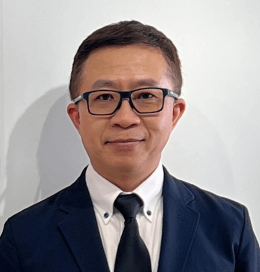
Dr. Tony T.F. Chan, is a specialist in General Surgery. He graduated from the Chinese University of Hong Kong in 1994.
Before commencing his private practice in 2007, he was the Associate Consultant in United Christian Hospital, with special interest in Head and Neck Surgery and Reconstructive Surgery. He had overseas training in MD Anderson Cancer Centre in Houston, Texas USA and Plastic Surgery Department in Chang Gung Memorial Hospital in Taiwan in 2004.
He started to develop interest in keloid treatment after witnessing the severity of the keloid problem in hong kong and high recurrence rate of keloid treatment in both public and private sector. Dr. Chan introduced intralesional cryosurgery for keloid treatment to Hong Kong from Israel Plastic Surgeon Yaron Har-Shai in 2013. He also visited and learned from renown surgeons in keloids treatment, like Professor Rei Ogawa, Plastic Surgeon in Nippon Medical School in 2018 and Dr. Deng Jun, Dermatologist in ChungQing in 2023 and Dr. Yang dongyun, Plastic Surgeon in ChungQing China in 2025.
He developed a day surgery centre offering integrated approach to keloid from simple injection, intralesional cryosurgery, to excision with postoperative radiotherapy.
Dr. Chan’s vision is to make keloid treatment simple and curable.
Abstract submitted for the 5th International Keloid Symposium
Alternative Treatments for Keloids Without Scalpels and Radiotherapy Keloids pose a significant challenge in dermatological treatment, even with the advancements in medical technology. These raised scars often result from abnormal healing processes and can be difficult to manage effectively.
Current Treatment Options A variety of treatment modalities are currently available for keloids, including:
• Intralesional injections: Corticosteroids are commonly injected directly into the keloid to reduce inflammation and scar tissue formation.
• Cryosurgery: This technique involves freezing the keloid tissue, which can help reduce its size and improve appearance.
• Surgical excision: While effective, this method often leads recurrence unless followed by other treatments.
• Radiotherapy: Typically used post-surgery to prevent recurrence, but access can be limited due to the need for specialized facilities.
• Laser/light therapy: This approach uses focused light to reduce redness and improve texture.
Currently, many practitioners advocate for surgical excision followed by radiotherapy as a standard treatment protocol. However, the availability of skilled surgeons and radiotherapy facilities can be a barrier in many regions. Proposed Alternative Treatment Approach We propose a combination of intralesional cryosurgery followed by adjunctive therapies such as corticosteroid injections and laser/light therapy as a viable alternative for treating keloids, ranging from mild therapy as a viable alternative for treating keloids, ranging from mild to severe cases. This approach leverages the benefits of cryosurgery to target the keloid tissue directly while minimizing invasiveness. The subsequent use of steroids can help manage inflammation and further reduce scar formation. Additionally, laser/light therapy can enhance cosmetic outcomes by improving skin texture and reducing pigmentation.
Presentation Overview
In our upcoming presentation, we will delve into the mechanisms underlying intralesional cryosurgery combined with steroid and laser/light therapy. We will also showcase treatment outcomes through typical case studies that illustrate the effectiveness of this alternative approach. This comprehensive analysis aims to provide insights into a less invasive yet effective strategy for managing keloids, particularly in areas where traditional surgical options may not be feasible.

